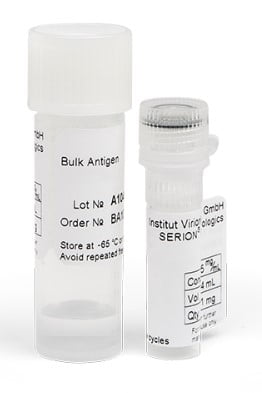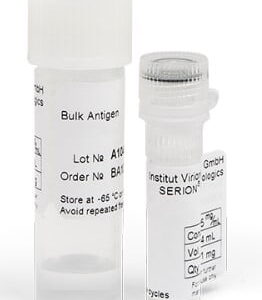| Weight | 1 lbs |
|---|---|
| Dimensions | 9 × 5 × 2 in |
| target | Helicobacter pylori |
| species reactivity | Helicobacter pylori |
| applications | ELISA |
| assay type | Indirect & quantitative |
| available size | 1 mg |
Helicobacter pylori Antigen BA118VS
$741.00
Summary
- Virion/Serion Immunologics Antigen for research use (RUO)
- Helicobacter pylori Antigen, recombinant
- Suitable for detection of IgA, IgG & IgM antibodies in ELISA
- Lot specific concentration, specified in mg/mL
- 1 mg
Helicobacter pylori Antigen BA118VS
| kit |
|---|
| Research area Infectious Disease |
| Storage Store at -65°C or lower. Avoid repeated freeze-thaw cycles. Sonicate before use. 10 years from date of manufacture (under recommended storage conditions). |
| Form liquid |
| Associated products Helicobacter pylori Antigen (BA118VS) Helicobacter pylori IgA Control Serum (BC118A) Helicobacter pylori IgG Control Serum (BC118G) Helicobacter pylori IgM Control Serum (BC118M) Helicobacter pylori IgA ELISA Kit (ESR118A) Helicobacter pylori IgG ELISA Kit (ESR118G) Helicobacter pylori IgM ELISA Kit (ESR118M) |
| target relevance |
|---|
| Organism Helicobacter pylori |
| Protein names Helicobacter pylori |
| Structure and strains Helicobacter pylori, previously known as Campylobacter pylori, is a gram-negative, flagellated, helical bacterium. Mutants can have a rod or curved rod shape, and these are less effective. Its helical body (from which the genus name, Helicobacter, derives) is thought to have evolved in order to penetrate the mucous lining of the stomach, helped by its flagella, and thereby establish infection. The bacterium was first identified as the causal agent of gastric ulcers in 1983 by the Australian doctors Barry Marshall and Robin Warren. |
| Detection and diagnosis In the diagnosis of H. pylori infections, a distinction is made between non-invasive and invasive methods. Invasive procedures contain histology, urease rapid test and microbiological techniques such as cultivation and PCR. The C13-breath test, the Helicobacter pylori antigen detection in stool samples and serological antibody detection based on ELISA or immunoblot belong to the group of non-invasive methods. The detection of serum antibodies can be used for therapy control after eradication therapy |
Data
Publications
| pmid | title | authors | citation |
|---|---|---|---|
| We haven't added any publications to our database yet. | |||
Protocols
| relevant to this product |
|---|
| BA118VS protocol |
Documents
| Product data sheet |
|---|
| BA118VS |
Only logged in customers who have purchased this product may leave a review.














Reviews
There are no reviews yet.